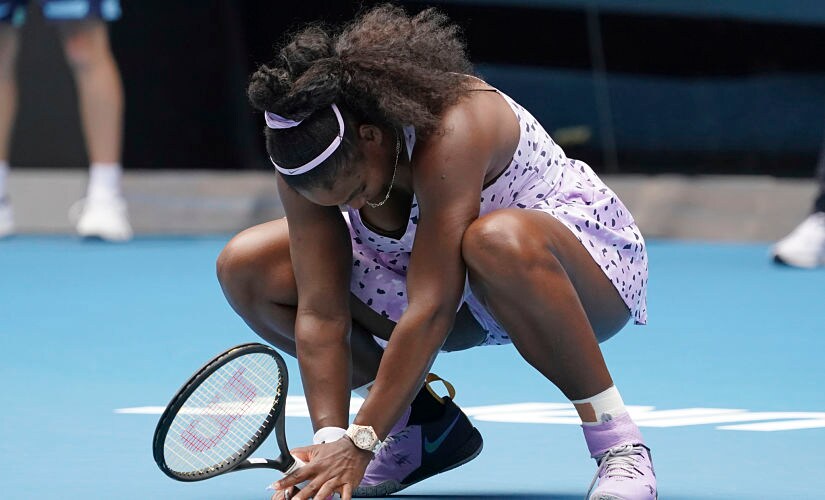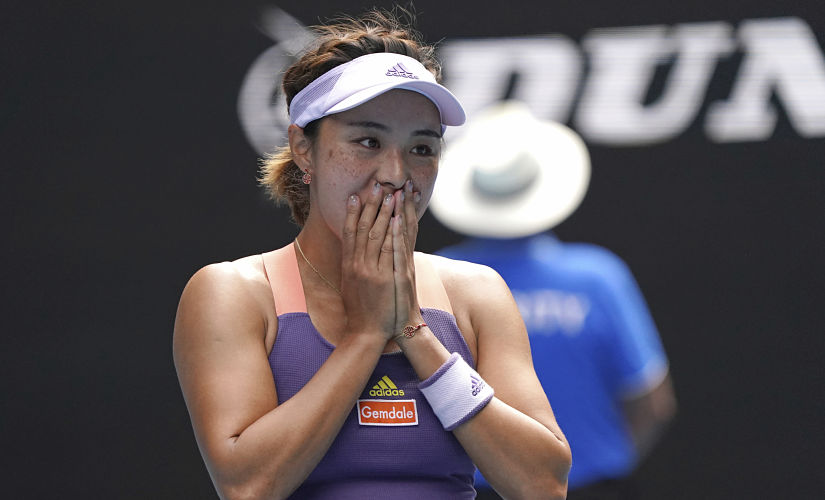There were two moments in the second set of Serena Williams’ third-round match against Wang Qiang that stood out more than any other. Serving at 1-1, 30-30, Serena hit a rally forehand that clipped the tape and dropped dead, giving Wang no chance to retrieve it. A piece of rank good fortune had prevented Serena from going break point down, and probably staved off a quick exit. But instead of apologising, as is customary, she turned around stone-faced and headed back to her mark. It didn’t take a genius to figure out that Wang had gotten under Serena’s skin. [caption id=“attachment_7951401” align=“alignnone” width=“825”]  China’s Wang Qiang after the win over Serena Williams at the Australian Open. AP[/caption] The second transpired a couple of games later, with Wang serving a break up at 3-2. At deuce, with chance to get a break point and with it a foothold back into the match, Serena hit a sharply angled crosscourt forehand that pulled Wang well wide of the doubles alley. On most days, that would have been a winning shot. But on this day, Wang scampered to her right, took one look at the ball, and powered a forehand down the line that kissed the paint for a clean winner. It was a response so incredible that Serena shot Wang a look of pure disbelief, as though saying, “How are you even doing this?” Serena went on to win the set, despite looking dead and buried until the very end, on the strength of nothing but her trademark fighting spirit. But those two moments, where she was driven to unbearable irritation and shocked disbelief respectively, showed just how much of a challenge she had on her hands. Who would’ve thought it would be Wang of all people providing that kind of challenge? The Chinese, as we’ve been reminded countless times over the last couple of days, suffered one of the worst beat-downs in history the last time she ran into Serena. At the 2019 US Open she lasted all of 44 minutes against the American, winning a grand total of 15 points and one game over two sets. And it’s not like she regrouped after that mauling; over her next six tournaments (including two this year) Wang put together a dismal 4-6 record, winning two matches in a row just once. A fall like that can happen when your breakthrough run to the quarterfinal of a Slam is ended as disdainfully as Serena ended Wang’s. And considering the Chinese was facing the source of her misery again on Friday, there were fears she would be crippled by at least some measure of post-traumatic stress.
Serena Williams falls in the third round of the Australian Open to Wang Qiang.
— ESPN (@espn) January 24, 2020
It’s the first time she’s lost in the first week of a hard-court major since 2006. pic.twitter.com/EoChzPMdEh
But strangely, there was a lot more stress on the other side of the net. Serena was slightly off from the start, missing regulation forehands and looking unsure of her footwork. She still managed to put that aside and carve out three break points at 3-2 in the first set, but when Wang saved them all, you could detect a sense of doubt creeping into the American’s mind. Wang has the game and the right ingredients to counter Serena ’s. It’s just that in New York, Serena was too dialed-in to let anything come in her way; on days like those, it is virtually impossible to make a dent in her game. But on Friday Serena never soared to those heights, which was all the invitation Wang needed to barge through the door. She made her first move at 4-4 in the first set. Serena missed a few first serves and forehands to concede the break, which allowed Wang to serve for it. From that point on, until pretty much the end of the match, Wang was in a zone that was too hot for even the G.O.A.T. to handle. It’s not that the 29-year-old blazed winners all over the court, or got every single ball back in play with Halep-esque defense. Instead, she executed to perfection what she does best: hit with depth, flat pace and angle on every rally ball, and refuse to concede court positioning come what may. Serena did step on the gas every now and then, and ended with 43 winners for the match. But she also hit 56 unforced errors, many of which came when she was pushed wide.
The scintillating numbers behind Wang Qiang’s stunner:
— WTA Insider (@WTA_insider) January 24, 2020
63% 1st serves in
69% 1st serves won
60% 2nd serves won
71% returns in play
5 of 6 break points saved
3 of 12 break points won
25 winners
20 unforced errors#AusOpen pic.twitter.com/qryhXaRwJ5
That was one of the key components of Wang’s game-plan: she kept placing the ball teasingly out of Serena’s strike zone, daring the American to go for the risky down-the-line change-up from awkward positions. The tactic more often than not elicited an error, and after a while Serena got so fed up with it that she started aiming her groundstrokes down the middle to try and cut off Wang’s angles. It didn’t work. “I just made far too many errors to be a professional athlete today,” Serena said after the match. She may have been exaggerating, but she had a point. The 23-time Slam champion might have still managed to escape with a win if her most important weapon – her serve – had been firing. We saw how much of a game-changer it could be at 5-5 in the second set, when Wang had two break points. Serena proceeded to hammer four consecutive big serves from there, which gave her enough momentum to clinch the ensuing tiebreaker. And when she did the same thing at 1-2 in the third set to save two more break points, many of us thought we were in for a typical Serena Houdini act. But the trusted ally betrayed her when she needed it the most, at 5-6 in the decider. Serena couldn’t get enough free points in that crucial game, and considering how consistent Wang was with her groundstrokes, that was a recipe for doom. Serena got just 56% of her first serves in throughout the match, and won only 50% of her second serve points. Those numbers wouldn’t make her happy in the slightest. What also wouldn’t make her happy, of course, is that she is still as far away from equaling Margaret Court’s record of 24 Slams as she was at the start of her post-childbirth comeback. As Patrick McEnroe said in the post-match analysis, it almost seems like Serena wants it too badly, and that is preventing her from being relaxed enough to play her best tennis.
As the stars would have it, there is a tribute tonight to Peter McNamara, Wang Qiang’s former coach, who passed away last year.
— WTA Insider (@WTA_insider) January 24, 2020
"I always dream about him. I think he can see what I play today. He will proud of me. I really hope he can be here watch I play.
"Yes, I miss him."
McEnroe also suggested that Serena’s intensity, which has helped her throughout her career, is actually hurting her right now. While the jury is still out on that, the questions will keep hounding her until she gets the job done at a Major. The questions were also hounding Wang after the match, although they were decidedly more pleasant ones. And just like her uncomplicated game that can reduce even the greatest of players to fits, Wang gave disarmingly straightforward answers that made us wonder how she makes it all possible. When asked in the post-match presentation how she still believed she could beat Serena despite her US Open thrashing, Wang said, “I do really hard work on the court and off the court. It’s really good work, yeah.” [caption id=“attachment_7951421” align=“alignnone” width=“825”]  Serena Williams suffered her earliest exit at Australian Open since 2006. AP[/caption] When asked whether she would celebrate Chinese New Year tomorrow, Wang replied, “No.” “A small celebration?” the presenter prodded. “No,” Wang said again, shaking her head and smiling. It was perhaps this tendency to keep things simple that helped Wang stay the course even after that ferocious second-set comeback from Serena. Many players in the past have wilted when forced to play a decider against a fired-up Serena, but Wang never backed off. She stuck to her game-plan even in the most trying of circumstances, refusing to miss, which ultimately ensured that her good work from the first two sets wouldn’t go in vain. Wang couldn’t stop giggling and smiling at the presentation, as she batted away the questions with her short replies. Her answers may not have told us much, but her smiles certainly did: if you put your head down and trust your instincts, turning the tables even after a 44-minute blowout is not impossible.


)

)
)
)
)
)
)
)
)



